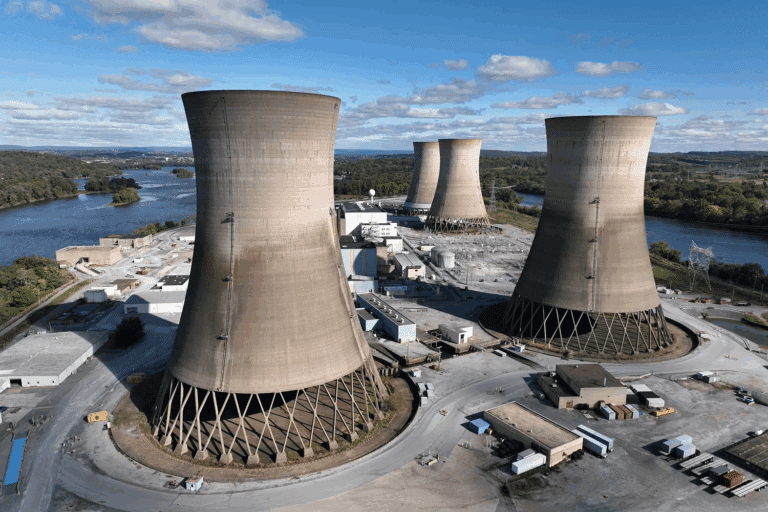On December 5, 2023, Dr. Noah Kaufman, Senior Research Scholar at the Center on Global Energy Policy and former Senior Economist at the White House, testified before the U.S. House Energy and Commerce Subcommittee on Energy, Climate, and Grid Security. The hearing examined opportunities to expand access to affordable, reliable, and clean energy. An archive of the livestream is available here.
My name is Noah Kaufman. I am an economist at the Center on Global Energy Policy at Columbia University SIPA. I study the economics of the energy transition, and my views have changed a lot in recent years because the data have changed. I’m thrilled to have the opportunity to share a few thoughts about those changes and their policy implications.
My testimony will make three points:
- The economics of the energy transition have dramatically changed, which has profound implications for economic policy strategies. There is no safe status quo option for policymakers to consider.
- Recent laws will reduce emissions and help American workers and communities navigate the energy transition. They will give domestic producers opportunities to compete in rapidly growing international markets for clean energy products. They will also take initial steps to support communities that depend on carbon-intensive industries for jobs and public revenues.
- Stronger international cooperation is needed to take full advantage of the improving economics of clean energy. Actions that support domestic producers and promote international cooperation are not mutually exclusive. Multilateral agreements can help decarbonize internationally-traded products, and international trade rules can be revised to be consistent with 21st century priorities, but only with strong U.S. government leadership.
The economics of the energy transition have dramatically changed
A decade ago, about 60 percent of utility-scale electricity capacity additions in this country were from fossil fuel sources.[1] Last year, about 70 percent of new capacity was from carbon-free sources in the United States, including renewables and nuclear.[2] Globally, carbon-free sources accounted for 80 percent of new capacity over the past three years.[3] Over the next three years, over 90 percent of additional global demand for electricity is expected to be met by renewables or nuclear energy.[4]
Cars may be the next major emissions source to reach this tipping point. A decade ago, sales of battery and plug-in electric vehicles (EVs) were well under 1 percent of total U.S. light-duty vehicle sales.[5] Last quarter, EV sales reached almost 10 percent,[6] and EV market shares are higher worldwide.[7] Two of the three most valuable car companies in the world are electric vehicles manufacturers,[8] and even a legacy automaker like Ford is reportedly allocating a majority of its capital and R&D investments to EVs and digital technologies.[9]
We are living in interesting times. Energy systems remain heavily carbon-intensive,[10] and global carbon dioxide emissions increased last year.[11] Nevertheless, when most of the new stuff being built and sold is clean, an energy transition becomes almost inevitable.
Indeed, annual global emissions appear poised to begin their descent. Each year, the International Energy Agency projects global carbon dioxide emissions under a range of scenarios, including with existing policies and with modest additional climate policies. A decade ago, both of these scenarios showed global carbon dioxide emissions increasing through the 2020s.[12] In this year’s report, the comparable scenarios show carbon dioxide emissions falling between today and 2030.[13]
These changes have profound implications for economic policy strategies. We have long known about the serious risks posed by climate change. Previously, countries may have justified inaction due to the risks of embarking on an energy transition. Now, with energy systems rapidly changing, there is no safe status quo option.
Recent laws will help American workers and communities navigate the energy transition
Recent laws passed by Congress—including the Inflation Reduction Act, the Bipartisan Infrastructure Bill, the CHIPS and Science Act, and the American Rescue Plan—include important measures to address the risks of climate change and the energy transition.
These laws will reduce emissions. Failing to take advantage of the improving economics of clean energy would be like leaving the proverbial $20 bill lying on the ground. Reducing emissions will save lives[14] and make people healthier and more productive.[15] [16]
These recent laws are also important steps toward preparing American workers and communities for a transition to clean energy. In recent years the United States has become the world’s largest producer of oil,[17] the world’s largest producer of natural gas,[18] and the world’s third-largest producer of coal.[19] In addition, over one million people are employed in the production of motor vehicles and associated parts.[20]
As the world shifts away from fossil fuels, other technologies and fuels will gain economic importance.[21] Before congressional action, the United States was essentially ceding rapidly growing markets for technologies such as solar panels and batteries to producers in China and other countries. Recent laws give American producers a fighting chance to compete in these international markets. Investments in clean energy manufacturing were $39 billion in the United States in the past year, more than double the previous year.[22]
Efforts to “onshore” manufacturing are often referred to as national industrial policy strategies because they address risks to national economic competitiveness and energy security. But the more salient risks of the energy transition are at subnational levels. About one thousand counties in the United States have some form of fossil fuel infrastructure;[23] in about 200 counties, fossil fuel jobs are over 5 percent of total employment.[24] The decline of dominant industries risks downward spirals for local economies that cannot attract or retain businesses, amplifying fiscal stresses and the ability of local governments to provide adequate public services.[25]
A strategy to achieve net zero emissions that works for the whole country needs to be paired with credible economic diversification strategies for fossil fuel-dependent communities.
Recent actions by Congress and the Biden administration take important strides in this direction. For example, they fund restoration projects at old mines and wells; they include carve-outs and bonuses to tax credits for projects in fossil fuel-dependent communities; they will support efforts at manufacturing facilities to convert to clean energy products; and they fund largescale projects for technologies like hydrogen, carbon capture, and nuclear energy that can be sited in these regions.[26]
These are only first steps. Communities need holistic economic development strategies, and in many places, energy-related projects may play only a small role.[27]
Even petrostates in the Middle East have recognized the importance of economic diversification, with national strategies to reduce the dependence of their economies on oil.[28] Dubai is an interesting case study: declining oil reserves forced the Emirate’s economy to shift away from a heavy dependence on oil, with the help of the national government.[29] Dubai has become a successful financial and tourist hub, and an international city that hosts events like the ongoing international climate change conference.
I am not suggesting the U.S. government should behave like a petrostate. However, if these countries can successfully diversify oil-dependent economies, the United States can too.
Stronger international cooperation is required to take full advantage of the improving economics of clean energy
Recent climate actions by Congress and the Biden administration have elicited two loud responses from the international community. One response has been applause for U.S. leadership in confronting a global challenge. Without these actions, the United States had little chance of meeting its climate commitments,[30] which would have dampened climate policy momentum across the world.
I am going to focus on the second response from the international community to recent laws: concerns about their large support for U.S. producers. Most countries cannot provide comparable support to their own domestic producers, and they fear that U.S. policies will put their producers at a disadvantage. These measures are also seen as violations of international trade rules that the United States, more than any other country, has been responsible for developing and enforcing.[31] These grievances are exacerbated by proposals for tariffs on embedded carbon dioxide in imported products, which would further advantage U.S. producers in domestic markets.[32]
While not their intent, these actions have poured fuel on the fire of geopolitical debates surrounding energy access and the energy transition.
Stronger international cooperation is needed to take full advantage of the improving economics of clean energy. Trade disputes can raise prices for American consumers, limit access to export markets for American producers, and slow innovations that require the diffusion of technologies and ideas across borders.
Fortunately, actions that support domestic producers and promote international cooperation are not necessarily mutually exclusive. The ongoing United Nations Conference of the Parties in Dubai is a good opportunity for the United States to showcase renewed leadership on international climate priorities.
I will mention two specific priority areas. First, decarbonizing carbon-intensive and internationally traded products will require broad multilateral agreements. Otherwise, low-carbon variants of products like steel will not be able to compete with the established carbon-intensive alternatives. Such agreements must be compatible with the industrial policy strategies of richer countries and the development goals of lower-income countries like India, where most future emissions with occur. A useful template is the agreement to phase out hydrofluorocarbons under the Kigali Amendment to the Montreal Protocol, which received bipartisan support in the U.S. Senate last year.[33]
A second priority is a modernized set of trade rules. The current World Trade Organization is not a credible arbiter for disputes related to the energy transition because its rules were not designed for 21st century priorities. Countries can negotiate revisions to trade rules that reaffirm the importance of minimal trade barriers and nondiscrimination while recognizing that governments will need to support communities at risk from the energy transition, nurture emerging domestic industries, and ensure energy security.[34]
Modern trade rules and standards for carbon-intensive products could benefit American producers. They will not happen without the prioritization and strong leadership of the U.S. government.
I will conclude by emphasizing that energy transition policies create important trade-offs for policymakers to consider. For example, how do we keep costs low for American consumers while ensuring American workers have high-paying jobs? How do we manage an energy transition that is sufficiently smooth for fossil fuel-dependent communities yet sufficiently rapid to protect vulnerable and voiceless people from climate damages?
My suggestion to this committee and to Congress is to please work together on solutions that acknowledge these trade-offs and address them head on. There are no perfect answers. However, given the rapidly changing economics of the energy transition, inaction by the U.S. government would be a disservice to Americans.
Thank you for the opportunity to testify.
[1] US Energy Information Administration, “Half of Power Plant Capacity Additions in 2013 Came from Natural Gas,” Today in Energy, April 8, 2014, https://www.eia.gov/todayinenergy/detail.php?id=15751#:~:text=In%20total%2C%20a%20little%20over,to%209%2C210%20MW%20in%202012.
[2] Susan Dlin, “US Generating Capacity Additions Down YOY in 2022; Solar Takes Top Spot,” S&P Global Market Intelligence, January 27, 2023, https://www.spglobal.com/marketintelligence/en/news-insights/latest-news-headlines/us-generating-capacity-additions-down-yoy-in-2022-solar-takes-top-spot-73918740#:~:text=Solar%20surpassed%20wind%20as%20the,Reliability%20Council%20of%20Texas%20Inc.
[3] Harrison Dreves, “At a Glance: How Renewable Energy Is Transforming the Global Electricity Supply,” National Renewable Energy Laboratory, September 26, 2023, https://www.nrel.gov/news/program/2023/how-renewable-energy-is-transforming-the-global-electricity-supply.html#:~:text=Net%20Expansions%20of%20Global%20Electricity,energy%20expansions%20over%20recent%20years.
[4] International Energy Agency, “Electricity Market Report 2023,” 2023, https://iea.blob.core.windows.net/assets/255e9cba-da84-4681-8c1f-458ca1a3d9ca/ElectricityMarketReport2023.pdf.
[5] Bureau of Transportation Statistics, “Hybrid-Electric, Plug-in Hybrid-Electric and Electric Vehicle Sales,” accessed December 1, 2023, https://www.bts.gov/content/gasoline-hybrid-and-electric-vehicle-sales#:~:text=Hybrid%20vehicle%20sales%20began%20in,light%20vehicle%20market%20in%202021.
[6] Jesse D. Jenkins, “The Myth of ‘Slowing’ EV Sales,” Heatmap, November 13, 2023, https://heatmap.news/electric-vehicles/are-ev-sales-really-slowing-data.
[7] International Energy Agency, “Tracking Electric Vehicles,” July 11, 2023, https://www.iea.org/energy-system/transport/electric-vehicles#tracking
[8] Julie Pinkerton, “The 10 Most Valuable Car Companies in the World,” U.S. News and World Report, October 16, 2023, https://money.usnews.com/investing/articles/the-10-most-valuable-auto-companies-in-the-world.
[9] BloombergNEF, “Zero-Emissions Vehicles Factbook,” November 2022, https://assets.bbhub.io/professional/sites/24/2022-COP27-ZEV-Transition_Factbook.pdf.
[10] Our World in Data, “Energy Consumption by Source, World,” accessed December 1, 2023, https://ourworldindata.org/grapher/energy-consumption-by-source-and-country.
[11] International Energy Agency, “Global CO2 Emissions Rose Less than Initially Feared in 2022 as Clean Energy Growth Offset Much of the Impact of Greater Coal and Oil Use,” March 2, 2023,
[12] International Energy Agency, World Energy Outlook 2013, 2013, https://iea.blob.core.windows.net/assets/a22dedb8-c2c3-448c-b104-051236618b38/WEO2013.pdf.
[13] International Energy Agency, World Energy Outlook 2023, 2023, https://iea.blob.core.windows.net/assets/42b23c45-78bc-4482-b0f9-eb826ae2da3d/WorldEnergyOutlook2023.pdf.
[14] Antonio Gasparrini, Yuming Guo, Francesco Sera, Ana Maria Vicedo-Cabrera, Veronika Huber, Shilu Tong et al., “Projections of Temperature-Related Excess Mortality under Climate Change Scenarios,” Lancet Planetary Health 1, no. 9 (December 2017): E360–E36, https://www.thelancet.com/journals/lanchi/article/PIIS2542-5196(17)30156-0/fulltext.
[15] Park, R. Jisung, Joshua Goodman, Michael Hurwitz, and Jonathan Smith. “Heat and learning.” American Economic Journal: Economic Policy 12, no. 2 (2020): 306-339, https://www.aeaweb.org/articles?id=10.1257/pol.20180612
[16] Intergovernmental Panel on Climate Change, “IPCC Sixth Assessment Report,” 2022, https://www.ipcc.ch/report/ar6/wg2/.
[17] US Energy Information Administration, “What Countries are the Top Producers and Consumers of Oil?,” accessed December 1, 2023, https://www.eia.gov/tools/faqs/faq.php?id=709&t=6.
[18] US Energy Information Administration, “International Energy Outlook 2021,” October 6, 2021, https://www.eia.gov/outlooks/ieo/production/sub-topic-03.php.
[19] International Energy Agency, “Coal Information: Overview—Production,” accessed December 1, 2023, https://www.iea.org/reports/coal-information-overview/production.
[20] Federal Reserve Economic Data, “All Employees, Motor Vehicles and Parts,” accessed December 1, 2023,
[21] Council of Economic Advisers, “Innovation, Investment, and Inclusion: Accelerating the Energy Transition and Creating Good Jobs,” white paper, April 23, 2021, https://www.whitehouse.gov/wp-content/uploads/2021/04/Innovation-Investment-and-Inclusion-CEA-April-23-2021-1.pdf.
[22] Lily Bermel, Jiale Chen, Brian Deese, Michael Delgado, Leandra English, Yeric Garcia, Trevor Houser, Aryaana Khan, John Larsen, Nakya Stewart, and Harold Tavarez, “The Clean Investment Monitor: Tracking Decarbonization Technology in the United States,” Rhodium Group, September 13, 2023, https://rhg.com/research/clean-investment-monitor/.
[23] Daniel Raimi, Sanya Carley, and David Konisky, “Mapping County-Level Vulnerability to the Energy Transition in US Fossil Fuel Communities,” Nature Scientific Reports 12 (2022): 15748, https://www.nature.com/articles/s41598-022-19927-6#additional-information.
[24] Analysis of US Census County Business Patterns (CBP) data by Resources for the Future.
[25] Adele C. Morris, Noah Kaufman, and Siddhi Doshi, “Revenue at Risk in Coal-Reliant Counties,” Environmental and Energy Policy and the Economy 2 (2021), https://www.journals.uchicago.edu/doi/full/10.1086/711307.
[26] Noah Kaufman, “The US Needs a Playbook for Place-Based Investments in Fossil Fuel Communities,” Energy Explained, Center on Global Energy Policy, Columbia University, August 3, 2023, https://www.energypolicy.columbia.edu/the-us-needs-a-playbook-for-place-based-investments-in-fossil-fuel-communities/.
[27] E. Mark Curtis, Layla O’Kane and R. Jisung Park, “Workers and the Green-Energy Transition: Evidence from 300 Million Job Transitions,” working paper, National Bureau of Economic Research, August 2023, https://www.nber.org/papers/w31539.
[28] Nader Kabbani and Nejla Ben Mimoune, “Economic Diversification in the Gulf: Time to Redouble Efforts,” Brookings Institution, January 31, 2021, https://www.brookings.edu/articles/economic-diversification-in-the-gulf-time-to-redouble-efforts/.
[29] International Monetary Fund, “Dubai Model of Economic Diversification and Development,” High-Level IMF-Ministry of Finance of Kuwait Conference on Economic Development, Diversification and the Role of the State, April 30 – May 1, 2014, https://www.imf.org/external/np/seminars/eng/2014/mcd/lahouel.pdf
[30] John Bistline et al., “Emissions and Energy Impacts of the Inflation Reduction Act,” Science 380, no. 6652 (June 2023): 1324–1327, https://www.science.org/doi/10.1126/science.adg3781.
[31] Noah Kaufman, Chris Bataille, Gautam Jain, and Sagatom Saha, “The US Broke Global Trade Rules to Try to Fix Climate Change—To Finish the Job, It Has to Fix the Trade System,” The Conversation, September 5, 2023, https://theconversation.com/the-us-broke-global-trade-rules-to-try-to-fix-climate-change-to-finish-the-job-it-has-to-fix-the-trade-system-212750.
[32] UN Framework Convention on Climate Change, “Agenda Item Proposal by the BASIC Group of Countries to be included in the Provisional Agendas of SBI/SBSTA, COP28, CMP18 and CMA5,” November 26, 2023, https://unfccc.int/documents/634014.
[33] Sagatom Saha, Noah Kaufman, Gautam Jain, Chris Bataille, “Green Gridlock: How to Fix the U.S.-EU Disconnect on Climate,” Foreign Affairs, April 25, 2023, https://www.foreignaffairs.com/united-states/green-gridlock.
[34] Noah Kaufman, Chris Bataille, Gautam Jain, and Sagatom Saha, “The US Broke Global Trade Rules to Try to Fix Climate Change—To Finish the Job, It Has to Fix the Trade System,” The Conversation, September 5, 2023, https://theconversation.com/the-us-broke-global-trade-rules-to-try-to-fix-climate-change-to-finish-the-job-it-has-to-fix-the-trade-system-212750.





